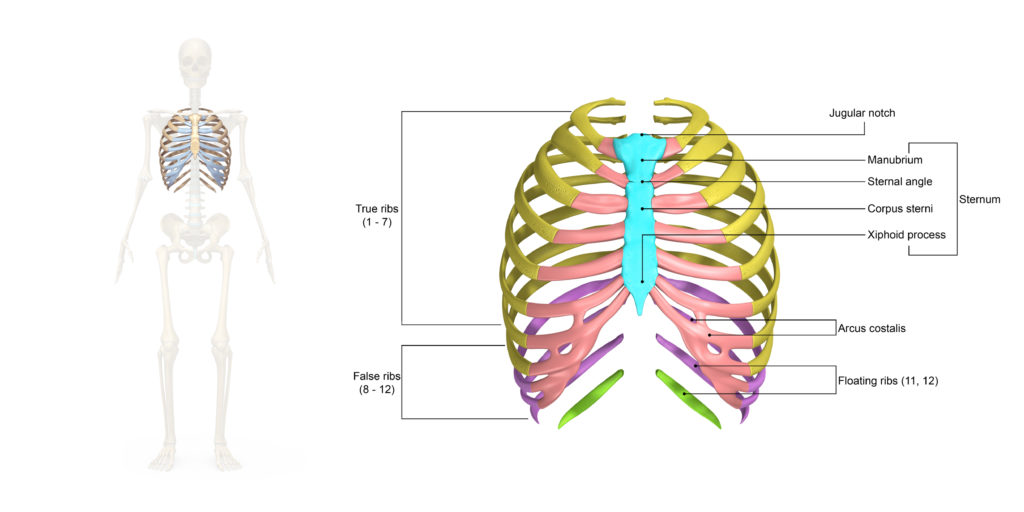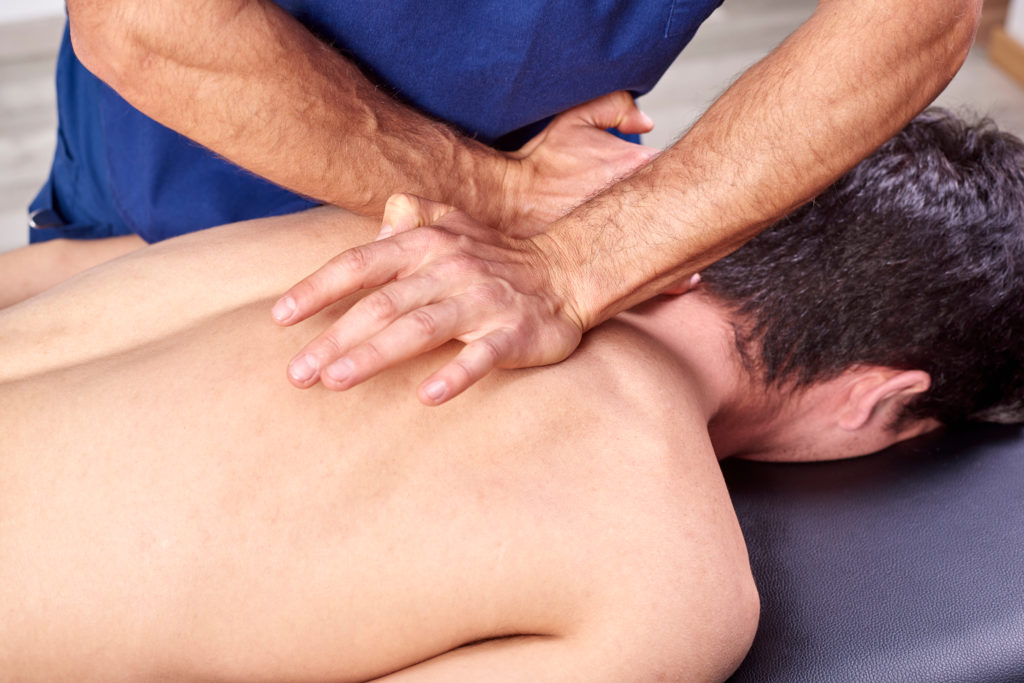Anatomy
The spine (vertebral column) typically consists of 33 vertebral segments grouped into five regions: cervical, thoracic, lumbar, sacral, and coccygeal. Certain individuals can be born with additional or fused segments affecting movement in its own way.
Thoracic Spine
The thoracic spine makes up the upper and mid-back consisting of twelve segments T1 – T12. Vertebral segments in this region have little motion because it’s connected to the ribs and breastbone (sternum). Flexion (forward bend), extension (backward bend), rotation, and lateral flexion (side bend) are available motions in the thoracic spine. Range of motion between any two thoracic segments is relatively small, however there is a decent amount of cumulative motion.
Its normal position has a forward flexed curvature, which is called kyphosis. Issues occur in this region that’s largely affected by your sitting or standing posture, but it’s not as common to injure compared to your neck and low back.
Ribs
There are 24 total ribs (12 ribs on each side) divided into three different categories from top to bottom: true ribs (1-7), false ribs (8-10), and floating ribs (11-12).
True ribs have articulations (direct connections) in the front and back of the body to the sternum and spine, respectively. False ribs have direct connections to the spine, but indirect connections to the sternum because it shares the cartilage of the seventh rib that connects to the sternum. Floating ribs are directly connected to the spine with no connection to the front of the body.
Muscles
There are three layers of muscles in the posterior trunk organized into superficial, intermediate, and deep muscle layers.
The superficial muscles of the back consist of muscles that reinforce the
scapulothoracic joint, or attach the scapula (shoulder blade) to the thorax. These muscles consist of the trapezius, rhomboids, levator scapula, latissimus dorsi, and serratus anterior. Visit the shoulder section for more information.
The intermediate muscles of the back are thought to function as breathing (ventilatory) muscles instead of moving or stabilizing muscles. These are the serratus posterior superior and inferior muscles.
The deep muscles of the back consist of three main muscle groups, however the most recognized muscle group in this layer is the erector spinae group. This muscle group courses the length of the spine from the neck to the pelvis and is roughly within one hand’s width from the center of the spine.

Common Causes Of Upper/Mid Back and Rib Pain
Repetitive motions and poor posture while standing or sitting can create more tension in
these muscle groups. Symptoms can vary depending on the type of injury and they will
typically be more severe if a certain posture or motion is maintained for a prolonged
period of time.
Other causes of upper/mid back and rib pain include:
- Poor sitting or standing posture
- Stress
- Poor breathing mechanics
- Excessive coughing/sneezing following common cold or flu-like symptoms
- Scapular dyskinesia
- Hypermobility
- Sports-related injuries
- Ligament sprains or tears
- Muscle strains or tears
- Fractures
- And more
Common symptoms include:
- Pain (aching, sharp, dull) when changing positions (i.e. sitting up or lying down in bed)
- Difficulty working at desk or workstation
- Discomfort with breathing
- Feeling of “heaviness” in upper/mid back and/or possibly shoulder region
How Physical Therapy Helps You
Upper/mid back pain and rib dysfunction can really limit your ability to work, sleep, and enjoy your hobbies. Your symptoms can be local (within the region) or referred pain from a muscle in a different area. A physical therapist can evaluate you to determine the cause of your symptoms to help manage pain, improve mobility, and restore strength.
Following the initial evaluation, your physical therapist will determine and discuss the cause of your pain or issues. Together, you and your physical therapist will set goals specific to your needs and create a plan of care. Your plan of care will help you accomplish your goals and get you back to what you enjoy doing!
Living with pain does not have to be your new norm. Contact us to get a free phone consult and schedule an initial appointment if you’re suffering from upper/mid back and/or rib pain.

480.269.1668